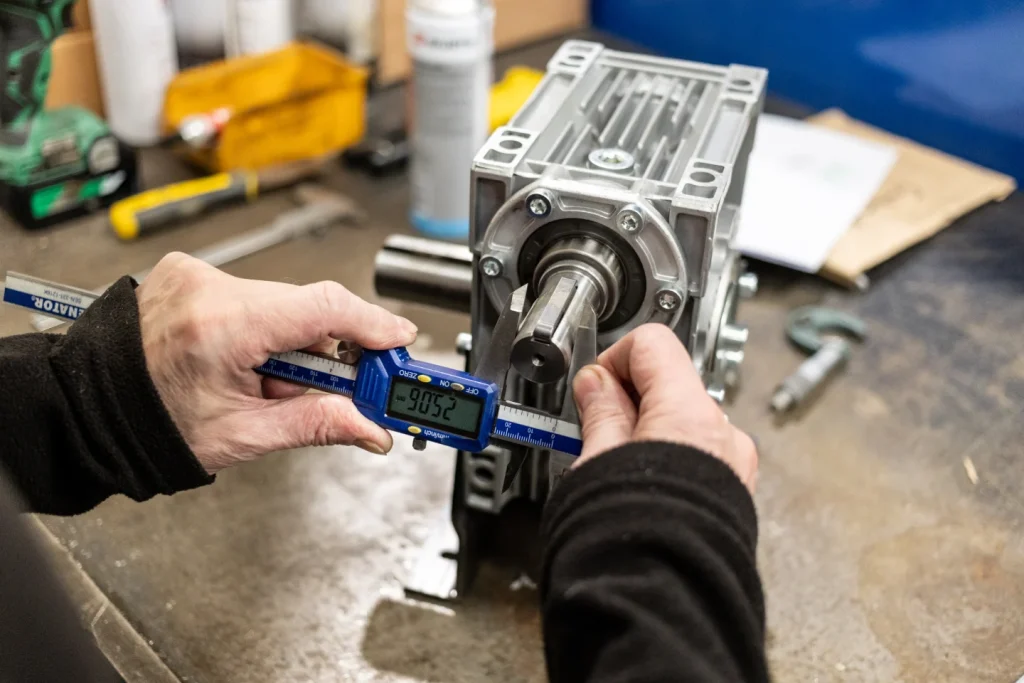Why correct gearbox specification is critical for OEM design success
In our experience, industrial gearbox specification is about so much more than power transmission, it’s about reliability, longevity, and protecting your production. We’ve seen first-hand how a mis-specified gearbox can cause serious problems: unplanned downtime, warranty claims, and even damage to reputation.
As we often tell our customers, if you specify the right gearbox, you shouldn’t experience downtime. When done properly, that gearbox can perform reliably for decades.
In industries such as food processing, logistics, recycling, and water treatment, the gearbox is truly mission-critical. Procurement teams need far more from a supplier than just the lowest price point, they need the assurance that their gearbox will deliver long-term performance and minimise lifetime costs.
Common gearbox types and use-cases
Different applications demand different gearbox designs.
The most common include:
-
1.
Worm gearboxes
compact and cost-effective, often used in conveyors and packaging machinery
-
2.
Helical gearboxes
efficient and durable, suited to heavy-duty applications such as quarrying or recycling
-
3.
Bevel gearboxes
ideal for angular power transmission, often seen in material handling systems
-
4.
Planetary gearboxes
offering high torque in a compact design, widely used in automation and robotics
From our perspective, each design has its strengths, but there’s no such thing as a one-size-fits-all gearbox, especially for the demanding environments we work with in OEM machinery.
5 key specification criteria engineers must consider
In our 50 years of gearbox design and supply, we advise five fundamentals which should always guide gearbox selection:
- Torque requirement – how much force is needed to rotate the load?
- Speed ratio – what reduction or increase is required?
- Duty cycle – will the gearbox run continuously, intermittently, or under heavy loads?
- Operating environment – dust, moisture, vibration, temperature, or corrosive conditions all affect performance
- Service life expectations – while many OEMs offer one-year warranties, we know the right specification can deliver far longer operational life
Many industrial gearbox failures come back to a simple oversight of these factors, something we’ve seen echoed time and again in our own work across different sectors.
Off-the-shelf vs custom gearbox design
We understand the appeal of off-the-shelf gearboxes when there’s pressure to control costs. However, we would strongly advocate considering custom gearbox design where performance and reliability matter most.
Custom gearboxes give OEMs greater control over torque, speed, and integration, and often provide more compact, efficient solutions. Customisation is one of the most effective ways to achieve both performance and design flexibility, something we witness daily in the projects we support.
From our perspective, the biggest gains come from reduced maintenance and improved sustainability, both of which are becoming increasingly important priorities for procurement teams.
How we approach OEM gearbox specification
At Brown GearTech, we always begin with two key pieces of information: power and torque, or torque and speed. With these details, our engineers can either select the right gearbox from our standard range of over 36,000 products or develop a bespoke solution.
From there, we drill into the application:
- Is the equipment operating indoors or outdoors?
- Will it be exposed to salt air, dust, or condensation?
- Is an inverter being used?
By asking these questions up front, we ensure every gearbox is tailored precisely to its environment and duty cycle.
Common mistakes that lead to downtime
We’ve supported OEMs for decades, and we’ve seen the same pitfalls crop up again and again:
- Underspecifying gearbox size in the drive to cut costs
- Overlooking environmental conditions
- Choosing torque or speed ratios that don’t align with operational needs
- Failing to consider inverter compatibility
- Failing to factor in servicing requirements or provide clear aftercare guidance for resellers and end users
These mistakes almost always lead to failure, downtime, and additional costs, exactly the problems we help our customers avoid.
Co-designing gearboxes with OEMs
One of the things we’re most passionate about is working in partnership with OEMs to reduce risk. Our co-design approach means we take the time to understand every variable, from torque loads to operating conditions, so the gearbox is right first time.
Industrial gearbox specification checklist for OEM engineers
Based on our experience, we recommend engineers always ask:
- What torque and speed does the application demand?
- What duty cycle will the gearbox operate under?
- Which environmental factors could affect performance?
- Would a custom gearbox deliver better long-term value than an off-the-shelf option
- Which UK gearbox manufacturer can provide ongoing technical support and supply continuity
These questions don’t just prevent costly mistakes, they also help build stronger, more reliable partnerships and better business outcomes for you.
Why OEMs choose Brown GearTech as their gearbox partner
For over 50 years, we’ve supported British and worldwide OEMs with gearbox supply and design. What sets us apart is our ability to design and manufacture bespoke gearboxes and geared motors in-house, while also offering long-term supply contracts that give OEMs the confidence their machinery will remain fully supported in the field.
In our view, choosing the right gearbox partner is as critical as choosing the gearbox itself. By working with Brown GearTech, OEMs can de-risk production, protect performance, and ensure reliability across mission-critical applications.
If you’re looking for a dependable industrial gearbox manufacturer to support your OEM projects, we’d be delighted to discuss how we can help.



